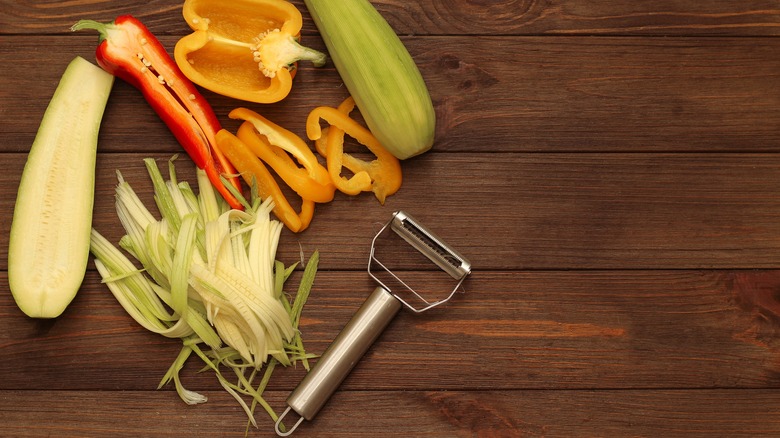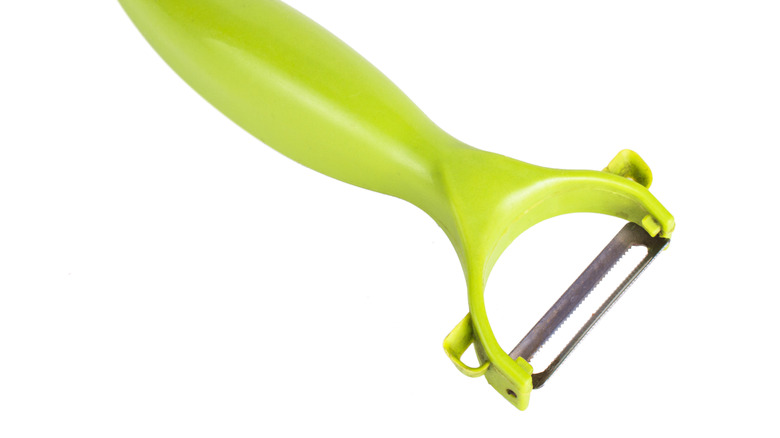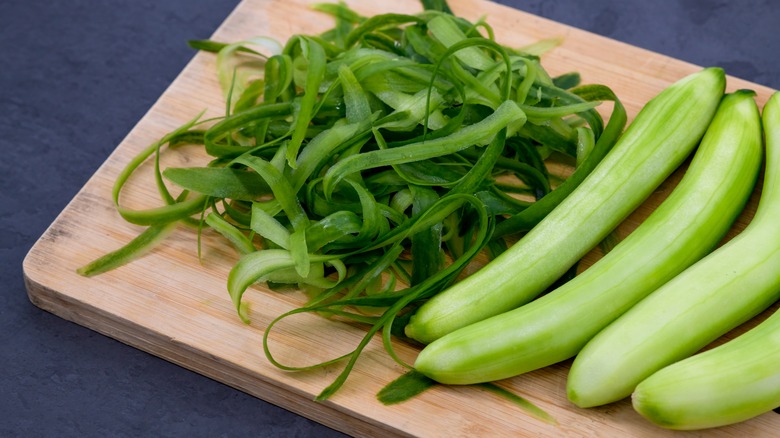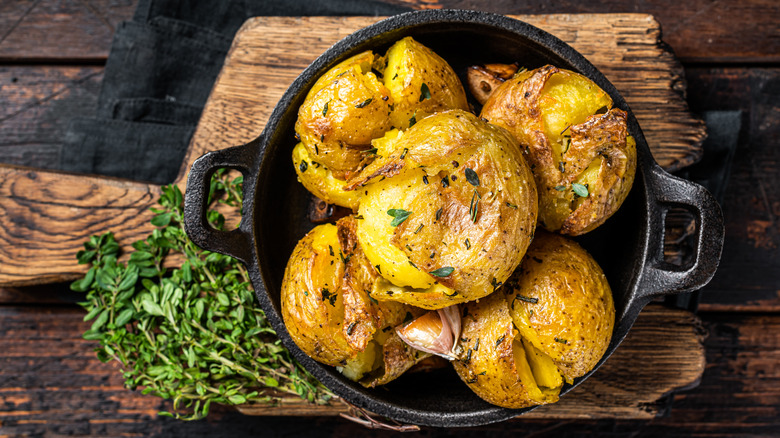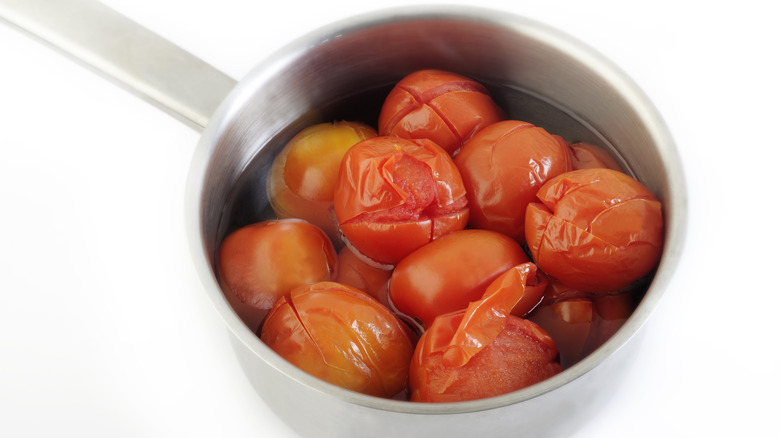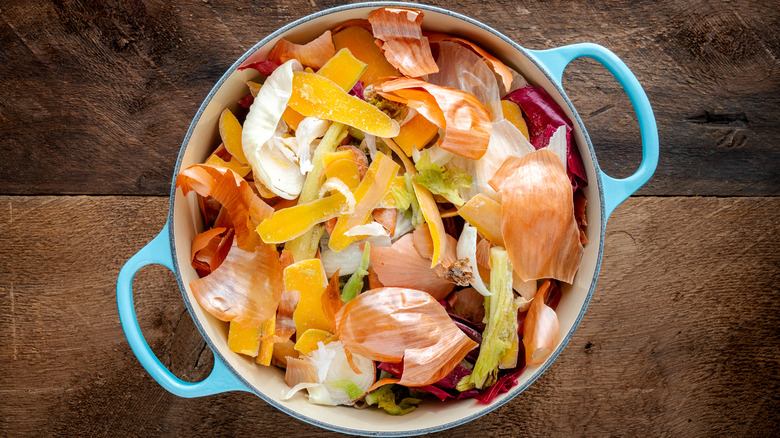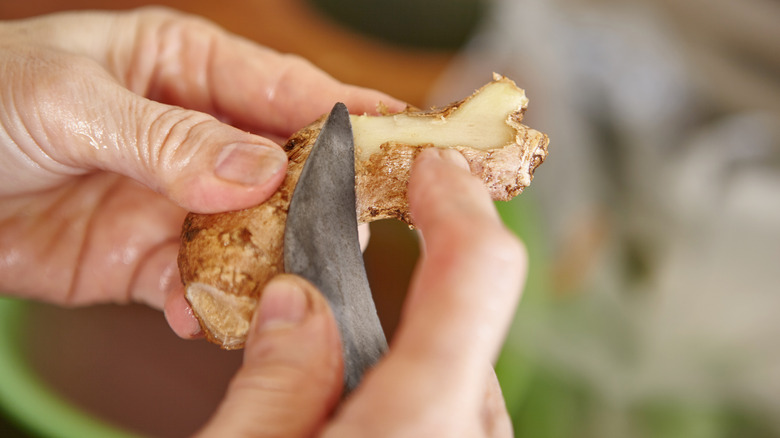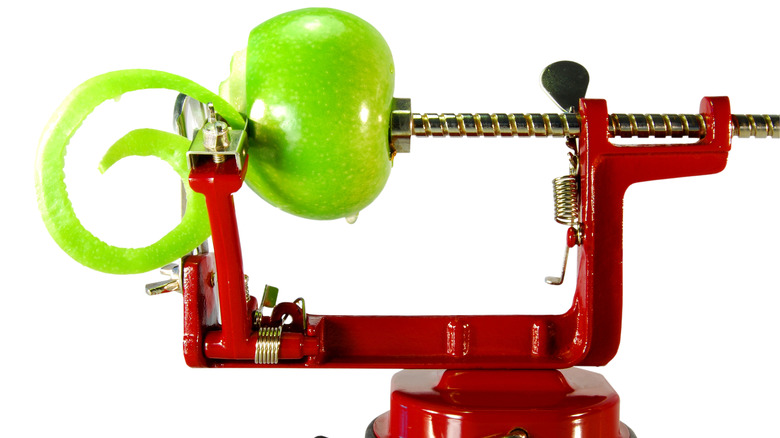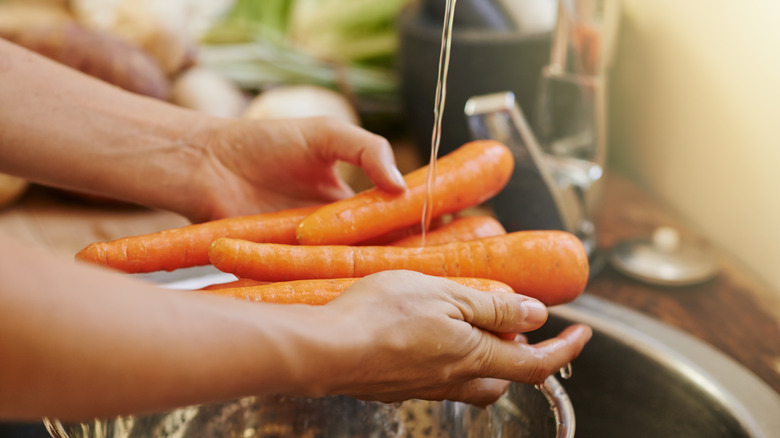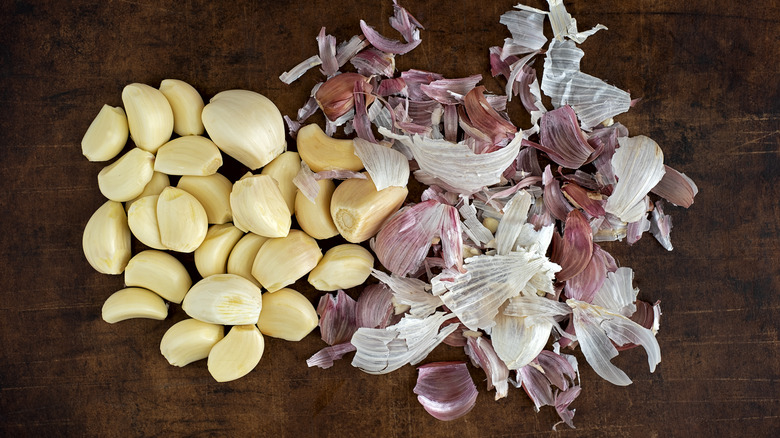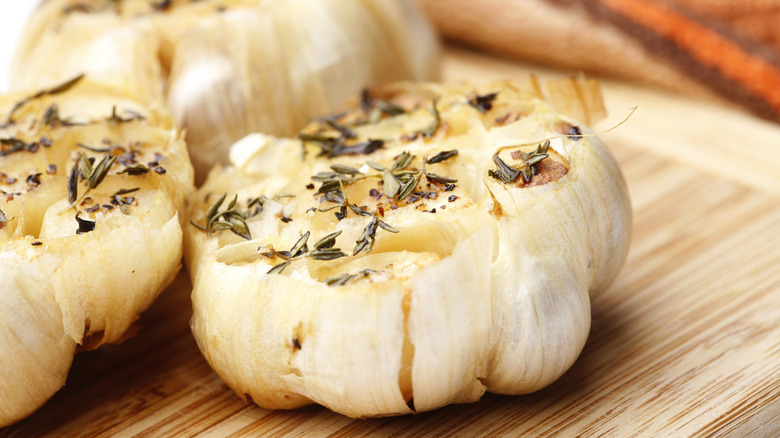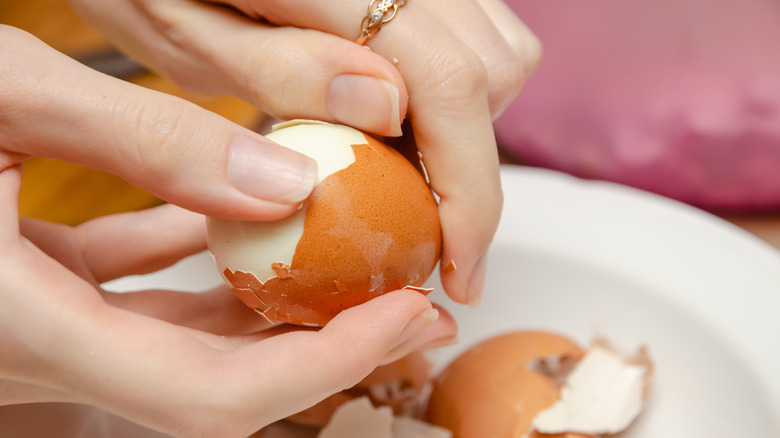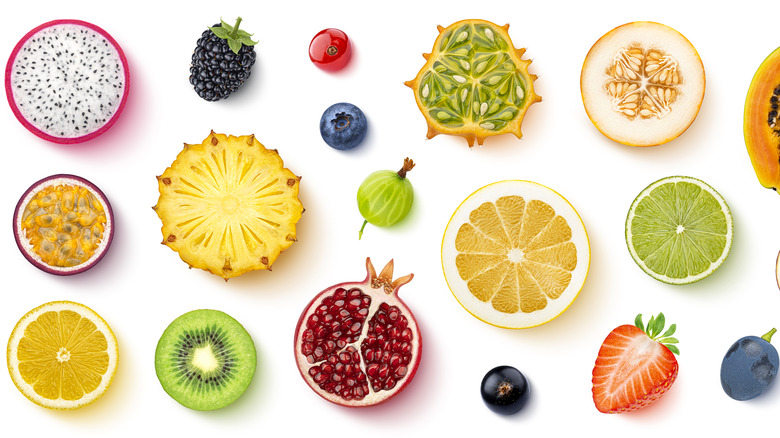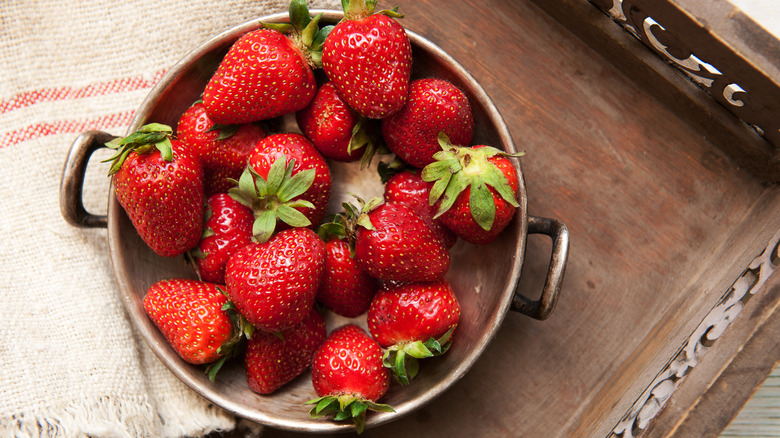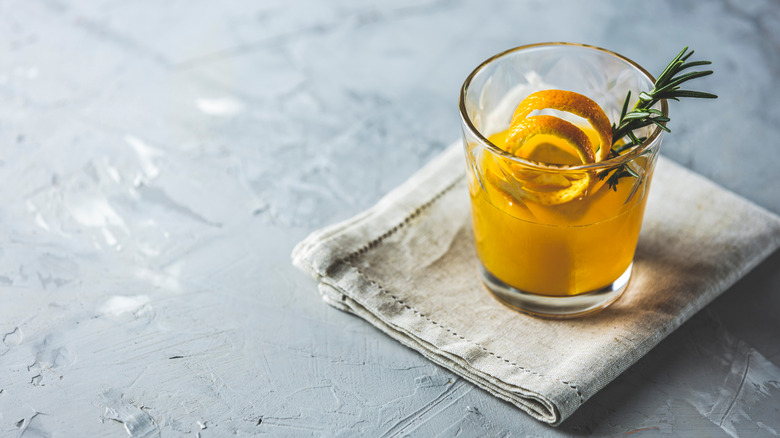15 Peeling Hacks To Cut Down On Food Prep Time
Whether you're preparing a beautiful summer salad or getting some hearty winter vegetables ready to roast, peeling can be a pain. It takes forever, sometimes you hack away good chunks of the fruit or veg, and occasionally even knick your finger. There has to be a better way to do this, right? The answer is yes. There are several tips and tricks to get you peeling efficiently and cut down on prep time.
Maybe you're in the mood for a fresh fruit smoothie, or maybe you're interested in sustainable kitchen practices and looking to limit food waste and maximize the value of your purchases. Either way, knowing how to peel, when to peel, and with what tools, can help keep prep to a minimum and take value to the max. It might be worth spending a little more on the best peeler, as dirt-cheap vegetable peelers sometimes just won't get the job done. With the right tools, these peeling hacks will take your kitchen prepping to the next level.
Get a Y shaped peeler and ditch the swivel
If you don't already have one, it's time to get a Y-shaped peeler. It's just what it sounds like, the blade runs horizontally to the handle, making it appear sort of like a letter Y. You grip the handle below the middle of the blade, rather than at the bottom, and you can easily pull the peeler without bringing the blade too close to your hand. Many leading product reviews list the Y-shaped peeler at the top of the rankings. These peelers are easier to handle, safer to use, and make the peeling process faster.
The standard swivel peeler can sometimes have a nifty pointed edge that can be useful, so it's not always the wrong choice. Different peelers have different ideal uses, and you don't necessarily have to toss your old one, but if you've only got room for one in your drawer, Y-shaped is the way to go. It makes a big peeling job, like getting through a whole bag of potatoes, a breeze. And it's easier to grip.
Leave some peel on
Sometimes, you don't need to fully peel your fruit or veg. If the skin is soft enough to chew, and the produce is organic, then there's no need to waste time meticulously peeling every bit of skin off. Now, if the peel is looking super waxy and thick to chew, or if you don't trust the way it was grown, you may want to peel it. But, oftentimes, a good rinse or scrub will do the trick in a fraction of the time. Certain varieties of apples, and most stone fruits, don't need to be peeled. In fact, a lot of the nutrients are found in the skin. If you're not worried about pesticides and other artificial additives, you can save yourself a lot of hassle at snack time.
Another option is to only partially peel some vegetables. A demi peel can keep a bit of nice color in your salad. When you leave the peel on or partially peel a cucumber, for example, you keep some of that deep green color on the plate. And those strips of peel you do take off? Well, try popping them in a pitcher of water. They'll still work to give that spa-quality cucumber water taste, and now you've gotten twice the use out of one cucumber.
Don't peel potatoes
Likewise, many varieties of potatoes don't need to be fully peeled. If you're making roasted or smashed potatoes, or even mashed potatoes, you can keep some peel and add nutrients and texture. Red potatoes, fingerlings, white, and yellow all have pretty thin skins. Smashed potatoes, which seem to be a trendy side dish these days, work best with the peel left on. That peel will sit between the flesh of the potato and the glass or spatula you're smashing it onto a baking sheet with. Potato salad can sometimes benefit from a little peel. And several mashed potato recipes call for only partially peeled potatoes.
Even russets, with their thicker, more fibrous skin, can be left unpeeled in many recipes. Baked potatoes turn out best when you prick the skin and salt them. The skin gets nice and crispy and you may even end up eating it in the end or using it to make loaded potato skins the next day. Another two for one.
Roast squash with the peel on
It's easier to roast squash with the peel left on. Many varieties will be soft enough to eat, and others will be easy to scoop the flesh off of once roasted and tender. If you're using butternut squash to make a sauce, for example, don't waste time peeling it first. Simply roast large rounds of squash and the peel will peel right off. Then pop the flesh into a blender and get to work making that creamy vegan pasta sauce. Sliced delicata squash doesn't need to be peeled either as the peel is thinner.
If you want to serve whole squash halves as a vegetarian or vegan main dish, you can definitely leave the peel on. Hasselback butternut squash may work best when peeled, but stuffed butternut squash or acorn squash filled with rice is an impressive and satisfying main dish best served in the peel. And zucchini and other summer squashes often have such delicate skins that you can eat them along with the rest of the flesh. Just make sure to give your squash a nice wash to remove any excess dirt or chemicals, then get straight to chopping and roasting and skip the peeling altogether.
Boil tomatoes and potatoes before peeling
If you're making tomato sauce from scratch or a massive batch of mashed potatoes for family dinner, you might struggle to get these ingredients peeled without wasting a good chunk of the vegetable and a lot of time. But, boiling tomatoes and potatoes before peeling them will save you a ton of time.
When making tomato sauce and other dishes requiring whole peeled tomatoes, you can drop fresh ripe tomatoes into a pot of boiling water for just a few minutes. The peel will start to buckle and split, that's when you know to pull it out with a slotted spoon and drop it into a bucket of ice water so it's cool enough to handle. Then the peel slides right off. No peeler necessary.
Likewise, sometimes boiling a whole or halved potato before peeling actually keeps the potato flesh from getting too waterlogged and makes it easy to pull the peel off. Simply score the potato around the center with a knife or scissors before boiling. Then, the two halves will be easy to slide off.
You don't alway need to peel an onion, like in broth
Onion peel isn't nice to eat. That's true. So if you're chopping onions for a soup or stew, serving them in a salad, or cooking them down into a dish you will want to peel them. But if you're using an onion to flavor a homemade broth or a roast chicken, there's really no need to peel it. As long as you've gotten any dirt off, you can leave the skin on your onions and shallots when they're not going to be eaten directly.
Many homemade vegetable broth and chicken or beef stock recipes include onions. You can even save up your scrap onion and other vegetable peels to make a tasty veggie broth from scratch. Similarly, when roasting a whole chicken, you may want to stuff the cavity of the bird with onion and lemon to help keep it moist and flavorful. In this case, don't feel the need to peel them first. It's a waste of time.
Use a spoon to peel ginger and tumeric
If you've ever tried to peel fresh ginger, you've probably encountered the trials of navigating those knobby little roots. There are loads of different angles, and you end up losing way too much of the ginger flesh to the peeler. The same goes for turmeric which has a similar shape and skin texture. When it comes to peeling ginger root or fresh turmeric root, ditch the peeler and opt for a spoon instead.
That's right, there's no need for a sharp blade when peeling ginger. The very thin peel will come right off when scraped with a spoon. This makes quick work of a previously tedious task and eliminates the risk of cutting yourself. Ginger is a healthy and flavorful root. Equally delicious in sweet and savory recipes, this powerful little root is a staple ingredient of many cuisines. If you make it easier to work with, maybe ginger will enter into the pantheon of frequently used ingredients in your kitchen, too.
Diversify your peeler selection
Now you've got a Y-shaped peeler in rotation, that'll make a lot of peeling easier. But there are several other specialty peelers out there that are designed for specific purposes. Serrated peelers are meant for softer bruisable fruits and veggies like tomatoes, eggplants, and peaches. In the case that you do need to peel those, try using a serrated peeler that cuts through the skin without having to press too hard thus bruising the fruit.
Julienne peelers are more of a knife replacement. These are designed to effortlessly slice your veggies into perfect equal strips in the classic French preparation. Julienned vegetables frequently appear in fresh salads or sautéed dishes. These matchstick thin slices can be very time-consuming to produce if you don't have chef-level knife skills, so a julienne peeler can be the perfect shortcut.
One more bonus peeler to have in your arsenal if you've got a little extra counter space is a rotary peeler. These are designed for apples and easily carve the whole peel off in a perfect spiral within seconds. It's the ideal tool when you're making homemade applesauce or apple pie. Anytime you have a load of apples to peel, a rotary peeler will make the job much easier and faster.
Scrub, don't peel, certain veggies
Some veggies like organic carrots, radishes, cucumbers, eggplants, potatoes, and parsnips do not usually need to be peeled at all if you weren't already aware. The "peel" is easy to chew and actually contains a lot of key nutrients. It takes less time than peeling to give them a little scrub to remove excess dirt. And if you use a firm bristle on carrots, some of the peel will even come off when you scrub them.
Next time you are getting ready to prepare a meal, take a second to think about which veggies you should be peeling and which you shouldn't before you really get things started. If the skin is thin enough and it is easy to scrub off any dirt, you may find you can skip that step after a good wash and save yourself a lot of time and hassle.
Smash, soak, or roll garlic before peeling
Garlic is another ingredient that can be a lot of work. Each small clove is covered in layers of thin, papery peel that can be hard to get off. Picking at the cloves with your fingers can result in a sticky garlicky affair that goes on forever. Next time your recipe calls for a load of garlic, try smashing the cloves under the flat side of a knife first. The layers of peel will separate easily and can then be pulled off with much less effort.
If you're able to plan ahead a little, you can also soak garlic cloves first to make them easier to peel. Or try this microwave hack for peeling garlic in no time. And if you're a fan of a niche kitchen gadget, there are also little silicone tubes designed to help you roll off garlic peel. Those can be a fun and easy alternative to peeling.
Roast and squeeze the garlic cloves right out
If you don't need the garlic to be sliced or minced in your recipe, skip the peeling entirely. Simply chop a whole head of garlic in half, drizzle with olive oil, and roast it in the oven along with your meat, potatoes, tomatoes, and herbs. The resulting roasted garlic will be sweet and tender, borderline mushy texture that you can squeeze right out of its peels.
This kind of sweet roasted garlic paste is perfect for making homemade sauces or garlic bread. Roasting garlic first will elevate the flavor profile of your next garlic break. Take the soft garlic and stir it into butter, perhaps with some fresh basil or oregano. Then spread the mixture onto a halved fresh baguette. You can top with a little parmesan and pop that in the oven for a few minutes. And if you want to keep it dairy-free, opt for olive oil instead of butter.
Cool your hard boiled eggs before peeling them
It can be time-consuming and frustrating to peel a hard-boiled egg. If you find you're losing chunks of egg white to the peeling process, you'll want to try one of these hacks to get an easy perfect peel.
First of all, if you've got a few minutes to wait, try cooling the eggs before peeling them. You can pop your boiled egg into an ice bath. Or leave hardboiled eggs in the fridge overnight and the shell comes off easily the next day. This is a great trick if you're going to be chopping the eggs for an egg salad, or making deviled eggs. In those cases, you won't mind if the egg is cold or the yolk is extra solid.
Another trick is to use baking soda when boiling eggs. And when you do start peeling, tap it on the counter gently a few times and then roll the egg across your counter or cutting board before peeling. The shell will start to crack and separate from the egg more easily.
Tricks for peeling tricky fruit
Some exotic fruits are almost more trouble than they're worth. But knowing how to peel them easily and effectively can put them back into your fruit bowl rotation. Mangos are delicious, but famously tricky to peel. The oblong fibrous pit can also be quite difficult to remove. There are some specialty slicers out there designed to remove the pit. Or try this clever TikTok mango-cutting hack to get to that tasty orange flesh.
The pomegranate is an odd fruit made up of hundreds of little ruby red seeds coated in tasty fruit flesh. These are set within several walls of pith that can be quite tricky to get around. There's no use taking a peeler to a pomegranate, you'll only end up frustrated and stained in red juice. Instead, learn how to cut a pomegranate properly and the seeds will reveal themselves perfectly to eat. Then you won't waste time peeling all that white stuff away with your fingers getting stained.
Pineapple is another delectable tropical fruit that can baffle the best of chefs. First of all, it grows in the ground, and not on a tree. Second, it's covered in spiky exterior skin that you certainly won't want to eat. Often sold pre-cut for an extra fee, follow these hacks for cutting pineapple yourself and fear no more.
Hull strawberries quickly with your peeler
Peelers can sometimes be used in ways you never realized. Standard swivel peelers will often have a pointed edge, and that's there for a reason. You can use the metal tip to easily carve out eyes from your potatoes, for example. And next time you're faced with a quart of fresh strawberries that need to be hulled, bust out the peeler and effortlessly get the job done.
Leaving the stem on is always an option when you're serving them whole, but when you want to macerate strawberries, stew them for jam, or mix them into a cake or pastry, you're definitely going to want to get rid of that leafy stem and the white hull inside too. You can do that with a paring knife, but that can be a tricky affair that often cuts out more than intended. Use the pointy end of the peeler to puncture into the strawberry, rotate, and pull out the whole hull and stem in one swift go.
Get more mileage out of those citrus peels
Okay so you spent a while peeling and now you've got a ton of scraps. Why not repurpose some of those peels? It'll make the work feel worth the effort and it'll save you time, energy, and money later.
You can use citrus peels to make homemade kitchen cleaners. Simply fill a jar with peels and pour white vinegar over them. Leave them to sit for a week or two, then strain out the peels and put the mixture into a spray bottle. The citrus will make that vinegar spray smell nice. You can also use those peels to make simple syrup for your next cocktail party. When boiling water and sugar, just pop a few peels into the pot. Their flavor will infuse into the syrup. Making homemade citrus simple syrup only takes a few minutes.
If you have a little more time to experiment, you can try your hand at a homemade limoncello. You can zest them first or simply place the peels in a jar with high-proof clear alcohol like Everclear. Or hey, even cheap vodka will do the trick. After a few weeks, the alcohol will have a powerful lemon flavor and be ready to mix with simple syrup. Your guests will be very impressed when you pass around a bottle of the house-made limoncello at your next dinner party. And you've saved a ton of peels from becoming a waste.
